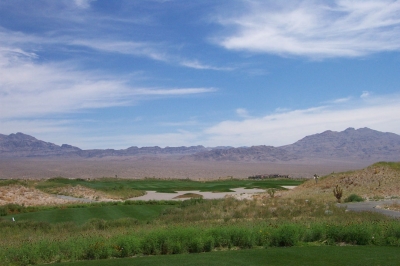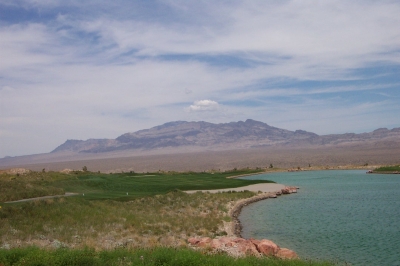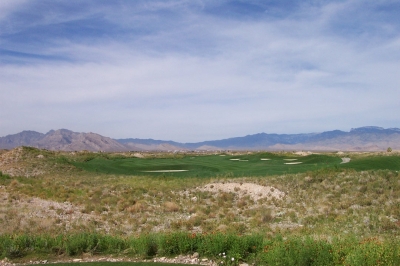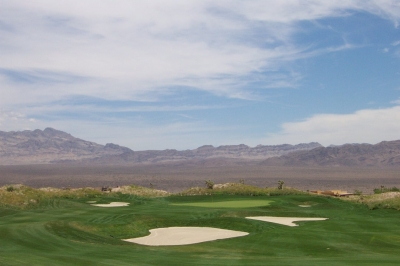By Jeffrey A. Rendall; Photos By Jeffrey A. Rendall
LAS VEGAS, NV – In any avid golfer’s sporting life, there will be continuous challenge – that’s one of the beauties of the game, and keeps us interested and motivated to try and improve every time there’s an opportunity to do so.
And thankfully, golf architects are just as interested and motivated in designing courses that’ll move with the times, yet continue to honor the grand traditions of the game. That’s what Pete Dye’s done out in the Nevada desert with the Wolf Course at the Las Vegas Paiute Golf Resort (about 20 minutes northwest of downtown Las Vegas), which not only compensates for distance advances in 21st century equipment technology – it accounts for future improvements as well.
 |
| Vintage Pete Dye on the Wolf Course's par three 8th hole -- a steep embankment to the right, and a huge mound to the left. |
Some might call it cutting edge; ahead of its time; or maybe it’s just reality – the golf ball flies a long ways these days, and the Wolf runs with it every step of the way.
Greg Frey, the Paiute Resort’s Marketing Manager, hits it right off: “Pete Dye designed the Wolf Course to be the tournament course at the resort. As a result, it’s very long, 7604 yards from the back tees. It’s a monster of a course.”
Monster’s not a word that conjures up very many pleasant images, yet it carries accurate descriptive value when talking about a golf course that’s several hairs longer than any layout I’ve ever seen. Having plodded through a couple 7,400 yard courses in the past, one can only surmise what an average of 11 extra yards per hole will do to an already damaged psyche from those experiences (note: there are five sets of tees, the shortest playing ‘only’ 5130 yards).
 |
| Click on the banner to book a tee time at Las Vegas Paiute Resort. |
Thankfully (in one sense), I didn’t get the chance to play every inch of the course, as the Wolf’s keepers limited the back tee setup to its more manageable 7009 yard distance from the black (listed 2nd longest on the card) tees. Even then, it was a massive challenge. The Wolf Course nicely compliments its more docile sister layouts at the Paiute Resort – Snow Mountain and Sun Mountain, which previously have been described as ‘gentle’ Pete Dye designs. But Wolf’s difficulty is more than extra real estate – it requires a higher degree of intelligent shot-making and placement from the tee box to take a score away. In other words, you’ll feel Dye’s ‘bite’ a bit more on the big boy course.
Frey says that was the intention all along: “The Paiute tribe wanted the third course to be more difficult than the first two. The Sun and Snow Mountain courses have garnered a reputation for being good tests of golf, yet probably aren’t hard enough to attract major professional events. So, Pete Dye built in some elements on the Wolf Course that would take care of those wishes. The Wolf is the longest, biggest, grandest golf course in southern Nevada. It’s got wide open landing areas, mounding, elevation changes, deep bunkers – a lot of dramatic design features. ”
That’s no overstatement. Having previously played the Paiute Snow Mountain Course, the thing you’ll probably remember most from that fine layout is the almost total absence of forced carries from the tee – and the more than generous landing areas, where you probably won’t lose a sleeve of balls the entire round, unless you’re finding the water more often than you should.
 |
| The 14th hole is one of five par fours playing 486 yards or better. You can chew off some distance on this dogleg right, but there are severe penalties if you don't make it. |
In contrast, on the Wolf Course, you’ll encounter some forced carries (from the back tee sets) over desert areas, and the native areas (with hydra seeded desert wildflowers) squeeze the fairways quite a bit more. Make no mistake, Dye still leaves a healthy dose of green carpet to hit the ball (as he always does) – but if you’re off it, you’re reaching for another dimpled sphere.
Even the newest course’s name denotes a departure from Paiute’s other offerings: “The wolf is an esteemed animal in Paiute Indian lore,” Frey explained. “It represents the wise teacher patiently guiding his students – but can also be ferocious, if the student takes a wrong turn. The course takes on that personality.”
Pardon the canine teeth marks on your legs after the round – wisdom would require you to hit it straighter next time, as the wolf ‘teacher’ will remind you time and time again.
 |
| This view greets you on the second shot of the par five 6th hole. You can try and navigate the hazards in front, or lay it up to the right. |
Pete Dye explained his thinking in creating the lengthy animal that is the Wolf Course: “I’ve been building longer and longer courses because the equipment manufacturers and governing bodies haven’t done a thing to control the golf ball. In 1992, the PGA Tour averaged 268 yards off the tee. Ten years later, they’re averaging 303 yards, so they’ve added over 30 yards in ten years. You can’t tell me all those pros are getting that much stronger in ten years’ time – that’s just wrong.”
He wasn’t finished: “And there’s nothing that indicates that the governing authorities are going to do anything about it, either. So hell, these aerodynamic engineers, they’ve got if figured out – if you swing at 120 mph, the ball will go x amount farther. What’s worse is the lady who swings at 60 mph – her ball won’t go one inch longer than the old Crow Flight ball made fifty years ago. That’s upside down, as far as I’m concerned.”
Ask for a thought, Mr. Dye supplies it, with gusto.
 |
| Looking from the 18th tee, you can see why Pete Dye said the Paiute Resort has a lot of 'ambiance.' |
“The Paiutes had all the land in the world out there, so there was plenty of room to build a long golf course – however long you wanted it. I built a course at Kiawah Island (in South Carolina) that was 7800 yards. The Paiutes could add even more length to the Wolf Course, if they wanted it,” Dye said.
The wolf may be endangered in the continental United States, but there’s no danger that the Wolf Course will become obsolete, at least from the yardage standpoint.
If you get beyond the math figures, you’ll notice some other noteworthy elements about the Wolf Course. Again, Dye expounds: “I think the Paiutes have got a great background for the golf courses there, great mountain scenery, a terrific ambiance. All of Las Vegas is tied into nothing, but that’s a great piece of property to build a golf course. It’s probably the only one out there quite like that.”
 |
| One of the tamer offerings on the Wolf Course, the 209 yard, par three 12th hole. |
It’s true, from what I’ve seen. Most southwestern desert-style golf is connected to some resort or hotel – where you’ll drive through a maze of luxurious buildings and beautiful landscaping to arrive at the golf course. Or, the course is part of a burgeoning new housing community. Or, within the confines of the city, contiguous to something.
Not so the Paiute Resort. You’ll head out of Las Vegas proper with its hyper-growing population, drive through some desert areas, and come upon the resort, planted in the middle of… nowhere, really. And to this point, it’s just golf at the resort.
Frey says the long range plans call for something more: “The land that the resort now occupies was deeded to the Paiute tribe by an act of Congress – I believe it was in the 1950’s. At that time, it was way out of town, and essentially worthless, just a place to go. Then they turned it into this amazing project.”
 |
| Here's one of those desert carries on the 495 yard, par four 7th hole. It's the Wolf Course's #1 handicap hole, and deservedly so. |
“They already have the three golf courses, and plans call for a fourth, as well as a resort village with accommodations, a spa, casino, shops, possibly some condominiums,” Frey added.
Playable golf courses, big names and beautiful scenery will attract interest for sure, but the one single element that’s most noteworthy at the Paiute resort is the course conditions. Even in the heat of summer, the conditions remain – perhaps the finest in the Las Vegas area, and some of the best you’ll find anywhere. It’s all in the water – and how much of it they can use.
Frey tells the story: “There was some question in the beginning about ownership of water rights on the Paiute land. The local utilities wanted to charge the tribe for water usage as they would for anyone else, but the Tribe successfully claimed in court that they are a sovereign nation – and that they owned the rights to the water, either above or underneath the earth, within their borders.”
 |
| No bailouts to the island green 15th hole. As you can see from the ripples on the water, the wind doesn't make it any easier. |
“So the tribe drilled wells right there on site. They do pay a reduced rate for water on the Wolf Course – but there’s no doubt, the water rights help in maintaining the incredible playing conditions out there,” Frey said.
You’ll find that lush greenery on every hole, but particular favorites included number six, a 537 yard, risk-reward par five that plays slightly downhill and usually downwind. The beauty of the hole is it’s potentially reachable for even average length hitters, if you can place your tee ball on the left-hand side of the fairway (avoiding a large waste area on the left and a bunker on the right). You’ll need to fly it over a pot bunker to reach the putting surface in two, but there’s ample room to miss, leaving a pitch and putt for a birdie try. A fairly easy hole, if you can stay out of trouble.
Another hole you’ll probably never forget is the eighth hole, a spectacular 206 yard par three with a deep bank off the right side with a sandy bottom – and it’s a long way down! Most folks will probably want to bail left, but Dye’s put in some collection areas over there that’ll make an up-and-down from that side a testy proposition. The beautiful mountain backdrop to the hole makes it quite a looker, too.
 |
| Click on the banner to book a tee time at Las Vegas Paiute Resort. |
On the inward nine, you’re certainly going to enjoy the 15th hole – a 182 yard par three to an island green. It might not necessarily be a Dye signature, but ever since he thought up the 17th at TPC Sawgrass, you’d come to expect an island somewhere along the line. The green is very large – keep that in mind when you’re on the tee box.
Finishing up, the eighteenth is another classic Dye monster, 496 yards in length (par four) with the tee shot over water to a dogleg right. Cut off as much as you dare to try and make the final approach shot of the day a manageable one. Frey says both the state high school championship and state amateur swung three shots on this hole last year. But isn’t that the purpose of the closing hole, to settle the match?
The Wolf Course at the Las Vegas Paiute Golf Resort certainly fills its niche – it’s quite a bit more difficult than the first two courses at the resort, and provides all the challenge and length necessary to ensure its place amongst southern Nevada’s best all around courses, for now and in the future. Enjoyable enough to warrant a howl at the moon, you might say.
 |
| The final approach shot of the day, to the 18th green. |
Extra: Thanks to David Brodsky and James Mobley for taking on the Wolf Course with me.
Details:
Las Vegas
Phone: (800) 711-2833; (702) 658-1400
FAX: (702) 658-5996
Website: http://www.lvpaiutegolf.com/
Course Designer: Pete Dye
Marketing Manager: Greg Frey
Head Golf Professional: Byron Cone
Tees/Yardage/Slope/Rating:
Tournament 7604 149 76.3
Black 7009 134 73.5
Yellow 6483 130 71.6
White 5910 119/125(L) 68.1/76.3 (L)
Red 5130 116 68.8
Rates:
Varies greatly by season, ranges from $69 in the summer months to $195 in high season (spring and fall).
Rates include cart, GPS and range balls.
| Related Links | Comments on this article? | |
|
Maryland National Golf Club Hollow Creek Golf Club Rocky Gap Resort PB Dye Golf Club in Ijamsville Whiskey Creek Golf Club |
E-mail Jeff Rendall, Editor: jrendall@golftheunitedstates.com |











